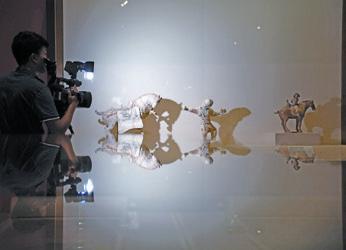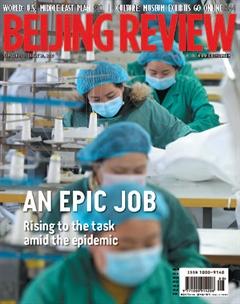Historical Lifeline
By Zhao Wei & Sudeshna Sarkar
For Lantern Festival, which fell on February 8 this year, the Palace Museum in Beijing, the imperial palace built 600 years ago and a famed tourist destination since 1925, presented an amazing sight. It was a vision in red and gold, bathed in the glow of multitudes of traditional lanterns hung across the sprawling complex, supplemented by ground lights and a radiant Moon.
“The museum was even more beautiful than when I saw it ‘face to face last year,” said Malini Biswas, a Delhi-based software engineer who loves to travel, both actually and virtually.“The special multimedia exhibition on the museum website on Lantern Festival scored over an actual sighting by giving you such a panoramic view. From my desk in Delhi, I could see the entire grounds as well as the areas outside the walls. It was simply magical.”
The museum, known as the Forbidden City when it was home to most of the Ming (1368-1644) and all of the Qing (1644-1911) dynasty emperors, is celebrating its 600th anniversary this year and it had lined up several exhibitions and events to mark the milestone. However, due to the novel coronavirus outbreak, it announced that it would remain closed till further notice.

To fi ll the gap, the museum, which already had an online presence, began to put multimedia presentations online to enrich peoples cultural life.
For instance, a collaboration with the Moscow Kremlin Museums features the Russian Court Ceremony exhibition at the Palace Museum, with over 150 priceless treasures such as paintings, jewelry and ceremonial garments as part of an online virtual tour.
The situation is the same in many museums, galleries and cultural centers across the country where activities have been temporarily suspended to control the spread of the outbreak. The National Heritage Administration of China (NHAC), which oversees museums and the protection of cultural relics of national importance, issued a statement saying that since cultural exhibitions have a special role in spreading knowledge and interpreting culture, museums are encouraged to host online exhibitions using existing cultural digital resources to provide safe and convenient online services to the public.
Accordingly, the NHAC commissioned a public platform for online exhibitions on its website. The goal, it said, is to promote the integration of new-generation Internet technology and the inheritance and development of Chinese traditional culture that will innovate communication channels and forms of museum exhibitions.
Biswas, who began visiting Chinese museums online after reading reports about the trend, found the results enriching. “Think of this,” she said, “at a time when Wuhan, where the epidemic is the worst, is under a lockdown, I took a ‘trip there. I visited the 1911 Revolution Museum online and it was an eye-opener.” The museum commemorates an uprising in the city in central China on October 10, 1911 that eventually led to the fall of the last imperial dynasty.
“Many people today think of Wuhan as the place where the virus originated. But one day, after the dust settles, maybe they will appreciate Wuhans place,” she said.
Encyclopedia of museums
Its a busy day for Fan Liting, who is a core member of the Baidu Baike Museums Project (BBMP). Working from home, she is overseeing several projects, especially one on Australian culture and nature with the Sydney Opera House, and other Australian museums and marine life protection associations.
The BBMP, the brainchild of Beijing-based multinational technology company Baidu, uses hi-tech to enrich lives. The non-profit cultural educational platform creates online museums or puts actual museums online by harnessing artifi cial intelligence, 3D technology, virtual reality and augmented reality.
The purpose, Fan said, is to let people feel like they are visiting the museum in person with detailed information in multiple languages.
“So many children are not able to travel around the world or visit museums or heritage sites, so virtual museums can help,” she said.
The BBMP works with both Chinese and foreign organizations. At home, its work includes putting the National Museum of China in Beijing as well as the Terracotta Army of Qinshihuang (259-210 B.C.), the first emperor of China, online. Viewers can scan QR codes for detailed information on the displayed items, while drones and facial recognition technology are used for a hi-tech touch.
For example, popular singer Hu Haiquan is the guide in a video specially produced for International Museum Day. His face and voice are used to make the Green-Faced Terracotta Warrior in the video come alive to narrate its own mystery. It is the only green-faced warrior among the 1,500 clay soldiers, currently reposing in the Shaanxi History Museum in northwest China.
According to Fan, the BBMP is working with about 300 museums throughout the world. “We plan to work with cultural institutions to enable thousands of people to visit them easily on the Internet,” she said. Though Chinese and English are the basic languages used, depending on where the actual museum is, there are several other language versions. For the Liangjiahe exhibition, a profi le of an unassuming village in the majestic Loess Plateau in Shaanxi Province widely known as the place where Chinese President Xi Jinping lived and worked for seven years, there are six language versions: Chinese, English, French, German, Korean and Japanese.
Online museums are not really a novel concept in China. Many organizations and enterprises like Baidu have been creating them for quite a while now, helping to preserve history. An ongoing BBMP project with the Okinawa Prefecture Government in Japan is rebuilding online the historical Shuri Castle, the palace of the Ryukyu kings who ruled from the 15th-19th centuries. It was destroyed during battle in 1945, then rebuilt to serve as a university but was ravaged by a fi re last year.
“We want to promote ideas about culture and wildlife and nature to remind people to protect our common culture and nature,” Fan said.
Museums apps
Museum lovers like Nan Yang have been visiting digital museums long before the coronavirus outbreak. The 34-year-old, who teaches at a school in Beijing, is a regular visitor to national fi rst-grade museums online. During the Spring Festival, he enjoyed Celebrating the Lunar New Year in the Forbidden City exhibition at the Palace Museum and the Elegance of the Tang Dynasty and Qin and Han Civilizations exhibitions at the National Museum of China.

Nan found that some online services had been optimized and strengthened. “This is not only a social education function, but is also paying attention to public health in consideration of public safety,” he said.
He has also seen museums embrace social media through Weibo and WeChat public accounts. During the Spring Festival, the National Museum of China launched a WeChat exhibition on A Dream of Red Mansions, one of the four Chinese classics written by Cao Xueqin (1715-63) in the Qing Dynasty.
The Capital Museum in Beijing launched the Capital Museum Radio on WeChat and a Listen to the Voice of Heritage segment to introduce cultural relics and history using professional narrators.
According to preliminary statistics, during the Spring Festival, more than 2,000 online or digital exhibitions were launched nationwide, while over 1,300 museums across the country have websites, WeChat, Weibo and other social media accounts.
The digitalization is also percolating to the grassroots. The China Cultural Heritage Information and Consulting Center, a non-profi t institution that works on cultural relics and collecting and managing museums information and databases, created Museum China, a national digital museum cluster. It showcases more than 180,000 collections from over 1,800 county or district museums.
There are also instances of collaboration between government departments and private enterprises. In January, Guangdong Province in south China and Internet technology giant Tencent cocreated Bo Wu Guan, or Museum Officer, a platform on WeChat providing 100 online museum services, including exhibitions and guided tours.
Bottlenecks to overcome
However, despite progress, digital museums still need to overcome many problems. Nan said some content, for example, is old while some presentations are oversimplifi ed, with only displays but no educational value.
“Copyright is extremely important to us because it constitutes the ownership of original work. We want to help artists and institutions protect themselves, and with their permission, we want to show as many beautiful things as possible to our audiences,” Fan said.

